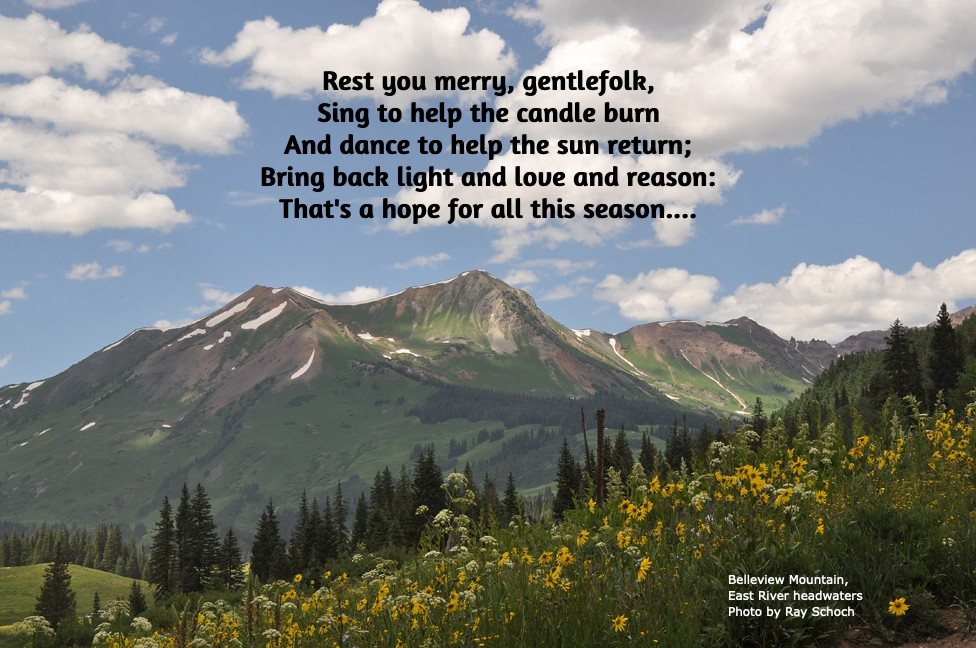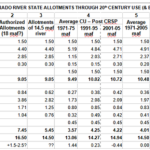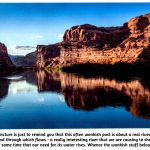
Enough gallivanting around the Mississippi Basin and its rivers; back to the troubled and troublesome Colorado River, currently experiencing its worst dry spell since around 800 CE. The Colorado Rivers, I should maybe say, since for all practical (human) purposes the river is now managed in a quasi-de jure way as two river basins under the Colorado River Compact and subsequent ‘Law of the River’ actions: an Upper Colorado River and a Lower Colorado River.
Previously here, I’ve been exploring the Colorado River Compact at its centennial, in what is certainly the worst year in its century. Here are some things I came up with in that exploration, that I don’t think are getting enough attention in our efforts to search our own souls and the soul of the river in the desert as we try to figure out where we are going from here:
1. The Colorado River Compact is not the ‘foundation of the Law of the River.’ The foundation of the Law of the River is the appropriation doctrine: the body of law that bases the right to use the water of the river and its basin (groundwater too, now) primarily on the seniority of use. First come, first served, for any economically beneficial use for as long as the use continues. Appropriations law is basically a powerful growth engine.
The Colorado River Compact, and all the subsequent laws, treaties, acts of Congress, and other consensual agreements involving the river thus become efforts to deal with the consequences of applying a powerful growth engine to an erratic and relatively modest river – and they fall short to the extent that they too cautiously circle around (or just ignore) the problem of a body of law encouraging unlimited demand on a limited resource.
2. The Compact could not do what its creators set out to do, so they settled for an expedient resolution to facilitate development of the River. The Compact was created because Euro-Americans wanted to control a rambunctious river whose erratic flows made it hard to use for civilized pursuits. But the growth logic of the foundational Law of the River (the appropriation doctrine) made six of the seven Colorado River states fear the pace of development of the seventh state, California, if the river were controlled; California could conceivably lay claim to most of the river’s water before the other states really got settled.
The six states thus wanted an ‘overlay’ to the unconstrained law of appropriation that would assure each state of enough water to meet their own future needs at their own pace. Unfortunately, they did not have – could not have had in the 1920s – enough solid information of what their reasonable future needs were. So they settled for an expedient resolution; they divided the river into two basins, above and below the uninhabited canyon region; each basin was given a little less than half the estimated flow of the river to develop, with the upper river basin committed to deliver a fixed amount of water to the lower river basin (75 million acre-feet over any ten-year period).
3. Mistakes were made. Much has been made of the fact that the Compact commissioners selected an estimated flow of 15 million acre-feet of water to divide between the two basins, well above what has been proven to be a more realistic estimate of an average annual river flow of 13 million acre-feet by E.C. LaRue and some other Geological Survey scientists. It was, however, well below the optimistic 16.8 million acre-feet estimate by the Bureau of Reclamation.
It was also an ebulliently optimistic time in America – the advent of the Anthropocene, when we thought we were on the verge of freedom from the stodgy limitations of nature. The commissioners acknowledged that they did not have enough information to accurately divide the waters of the river seven ways, and were content to leave that task ‘to the hands of those men who may come after us, possessed of a far greater fund of information.’ We now know that they should have listened to the USGS scientists, but it is easier and kind of superior to tsk-tsk as ex post facto Monday morning quarterbacks, than it is to acknowledge and understand – maybe even regret the loss of – the spirit of the times when the mistake was made.
The Compact commissioners have also been faulted for ‘leaving the Indians out of the Compact.’ That is not entirely accurate; what they said was that ‘Nothing in this compact shall be construed as affecting the obligations of the United States of America to Indian tribes.’ But what was the obligation of the United States to the Indian tribes?
On the one hand, in 1908 the U.S. Supreme Court had decided, in a case involving an Indian reservation in Montana, that when the federal government reserved public lands for any specific purpose, such as an Indian reservation, that it also implicitly reserved enough water to carry out that purpose. In the case of an Indian reservation, this meant enough water to teach the Indians to be farmers rather than hunter-foragers – meaning irrigation water, in the West.
But on the other hand, when the Compact was created in the early 1920s, the federal government was aggressively pursuing the ‘soft genocide’ of forced assimilation. Between 1900 and 1925, the number of Indian youth essentially kidnapped into ‘Indian Boarding Schools’ swelled from around 20,000 to more than 65,000. The official policy was ‘kill the Indian to save the man.’ The Compact commissioners were all white professionals receiving mixed messages from the government, and might be expected to think, even hope (river gods forgive them), that any Indian water claims might fade away if government policy succeeded – which it didn’t, no thanks to federal Indian policies before or since. And a reserved water obligation for the reservations remains an untransacted and pending commitment.
So yes, the Compact kicked some cans down the road, that it’s now time to pick up and deal with. But no one seems to be saying anything about a much larger and more consequential Compact mistake….
4. Dividing a desert river basin into two river basins is not a good idea. It worked – sort of (Arizona didn’t accept it) – as a temporary fix to break the logjam of not knowing enough to make an equitable seven-way division of the waters. What made the two-basin Compact work at all, sort of, was the fact that, until the construction of Glen Canyon Dam, the river itself, flowing unconstrained past Lees Ferry, kept the water supply (nearly all from the Upper River Basin) united with the growing water demand (mostly in the Lower River Basin).
But once the big dam near Lees Ferry was in place, the supply-demand distribution became a management problem that gradually succumbed to bad power politics. The Bueau gave the Lower River Basin its Compact allocation and more, regardless of growing water supply problems upriver, and the Upper River Basin developed a large supply of justifiable but unproductive resentment. The Compact, which confused ‘equitable’ with ‘equal’ in its division between two basins, is broken by the dam that turns it into two rivers, one supplying the other in ways both unequal and inequitable. It’s not the ‘structural deficit’ per se, but the refusal to address it, that breaks the Compact.
So – what can we do? How do we muddle forward from where we are now? No one is asking me, but of course I have some thoughts….
First and foremost, we should reunite the two river basins into one squabbling river basin (with transbasin extensions). Drop the expedient Compact solution of two river basins – a mistake perpetrated by subsequent ‘Law of the River’ measures, and finally fatal when the Colorado River Storage Project Act enabled building a wall – literally – between the two river basins.
This reunion would have to start with a consensual seven-state agreement – a new compact, if you will, to execute the task deemed impossible in 1922: a seven-state division of the river’s use. After a century of development, this has been achieved, de facto, and equitably enough. The lower river basin states get the consumptive use of almost twice as much water as the upper river basin, but they spread it over far more people and quite a bit more (and more productive) ag land.
This will not be easy, of course – but nothing ever is in the Colorado River region. California and Arizona have gotten so used to using ‘undeveloped upper river basin water’ that they’ve forgotten that that ‘surplus’ hasn’t existed for decades. They think the ‘structural deficit’ is an act of God about which nothing can be done, rather than just the consequence of their growing on borrowed water, a loan now being called in. But the hardest part for the lower river basin will come when the firm numbers for present use apportionments by state all have to be converted into percentages of the diminishing whole river – which the upper river basin states have already been doing, living closer to the vagaries of a desert river. The upper river states will no longer have to fear a call from the lower basin states, so long as they stay within their apportioned percentage of what’s there.
The real reunion of the basins into one river might begin when those in the lower river basin acknowledge that the water supply for the river’s desert lands comes mostly from snowfall in mountains in the river’s headwaters. This suggests that the downriver users of a desert river should accept some responsibility for the maintenance and improvement of the river’s mountain headwaters, their water supply. And those in the upper river basin would need to acknowledge the need for that help, especially if it is financial.
‘Maintenance and improvement’ of the water supply? Can we ‘improve’ the water yield from a river’s headwaters? An undigested fact about the mountain headwaters of the Colorado River Basin is the scientists’ consensual estimate that somewhere around 90 percent of the precipitation that falls over the river basin does not make it into the river. It either returns fairly quickly to the heavens as water vapor, or soaks into the ground to be transpired by trees, grasses and other plants back into the atmosphere. Scientists estimate that as much as a third of the precipitation that falls is lost through sublimation in the high headwaters: snow and ice being vaporized by sun and wind without even turning into water first.
Some quantity close to another third of the precipitation is transpired through the forests that form a broad band around the headwaters reaches of the river. Contrary to Forest Service founder Gifford Pinchot, the forests are not ‘father’ to the rivers that work their way through the forests; the forests are just some of the first major ecosystems that depend on the river’s water for their life. We love and need the forests, and they do provide shade and shelter for the snow that makes it through the trees to the ground – but they also drink a lot of water (more as the ambient temperatures increase), and not always for their own betterment; the density and age of forests we have protected from cleansing fires result in the consumption of a lot of water by big old forest trees not really getting enough to be healthy.
Those forests are almost entirely managed by the U. S. Forest Service, management that must include the long-term health and well-being of the forest itself rather than just short-term commodity production. But are there ways to manage a healthy forest that maximizes the Forest Service’s 1897 organic act charge ‘to secure favorable conditions of water flows,’ as well as (or instead of) the charge ‘to furnish a continuous supply of timber’? We don’t really know, because the Forest Service has not paid as much attention to optimal water management as it has to optimal timber management. We do know, however – for one example – that timber managers favor denser stands to produce tall trees with less branchiness, but that density increases the amount of snow intercepted by trees, which increases snow loss through sublimation.
To even learn how to maximize water yield from the headwaters’ rocks, ice and forests will require experimentation, trying things out, and it will require creative scientists and lots of boots on the ground that the perpetually under-funded Forest Service cannot afford. If, however, all forty million users of the Colorado River’s water thought of themselves as part of the whole river’s watershed, top to bottom, they might be willing to pony up a pittance for the health and vitality of the headwaters that produces their water. This is already happening to a modest extent; some of the big dogs in the Lower River Basin – the Metropolitan Water District, the Southern Nevada Water Authority, the Central Arizona Project – are contributing funding to a cloud-seeding project in the river’s headwaters, to increase snowfall from selected storms. That is a beginning.
And the next steps? Well, at some point, we have to descend into the cellar foundation of the Law of the River, and figure out how to adapt the frontier instincts of the appropriations doctrine to a civilization of 40 million. As Tom Buschatzke, Arizona’s Director of Water Resources said, just last week at the meeting of the Colorado River Water Users convention: ‘The single biggest roadblock to solving the problem of stabilizing the river is the priority system.’
There will be more on this imagined reuniting of the two rivers and their basins. Stay tuned.




From your lips to the ears and hearts of “the powers that be”
This is very good Grorge, and I presume you’ll have something more to say about Indian lands?
Yes….
Hi George,
Interesting information this provides about improving the “yield” of water at the River’s headwaters.
The Denver Post’s Colorado River article this past week covered the Colorado River Water Users Convention too. I had no idea that 30 ! Native American tribes own rights to as much as 30% of the water. The reporter mentioned that when the conference chairperson introduced the seven states at the meeting, she didn’t mention the tribes at all.
It’s discouraging–the whole situation–, but I’m a junky for information.
Thanks, Paula
The Indian nations have not been entirely ignored. In the 1940s, the Headgate Rock Weir Dam was built across the Lower Colorado River, below Parker Dam, and is administered by the Bureau of Indian Affairs to irrigate lands on some of the small reservations of the nations known collectively as the Colorado River Indian Tribes – all right on the river’s main stem. In the 1960s, Navajo Dam was built on the San Juan River as part of the Colorado River Storage Project, and the federal government began work on a Navajo Indian Irrigation Project; in exchange for the government building the project for them, the Navajos traded part of their reserved water rights. More recently, around the turn of the century, a much reduced ‘Animas-La Plata Project was built above the Animas River near Durango, to release water into that river in exchange for water on the adjacent La Plata River that can instead go to the Ute Indians, fulfilling an old obligation there. And now construction is going on for a big domestic-water pipeline across much of the Navajo Reservation from Navajo Reservoir.
The ‘federal reserved water rights’ concept was based on the fact that the Indians were forced out of their preferred historic hunter-forager cultures onto reservations in order to teach them to become farmers – naively assuming they would want to become ‘civilized.’ Many did not, seeing how much hard work was involved in farming compared to their relatively free and leisurely, albeit precarious, hunter-gatherer culture. But where the Indians in the West were willing to give farming a try, water was needed for irrigation. Hence, the argument that creating the reservation implied reservation of enough water to carry out that purpose – never mind, the chaos that wrought in the appropriations doctrine….
I admire your ability to grasp the complexity of this situation. I must admit that after reading much of what you write here multiple times, I cannot exactly grasp it beyond the basic simplicity that there isn’t enough water for all who live here. My own sense of the true nature of things tells me real solutions do not come from water Boards, Committees for advanced studies, politics, or government. But that is of little use and not at all helpful. So I will just shut up and send as much goodwill as I can muster to all you who are working to figure it out.
Well said. I hope (fruiitlessly, no doubt) that some big dogs read and heed. ken
George, this comes on the heels of a program hosted by the Hotchkiss-Crawford Historical Society in July 2022 presented by Aaron Clay, now retired Water Referee based in Montrose, Colorado, and intersects with some of the prognostications offered by Mr. Clay at that gathering. The focus of the program was “The History of Water in the North Fork and Smith Fork Valleys” from which area you derive some of your personal integration with the matter of water development and conservation. At the Historical Society we are considering a project in concert with the Bureau of Reclamation for cataloging the history and cultural mitigation of ditch improvement projects in the valleys and potentially providing a neutral venue for discussions of perhaps some of the issues you identify in your current essay. Thank you for sharing these thoughts, and as always, it will take me some time to digest all of them. In the meantime, I’m enjoying the 1st edition of Dragons in Paradise that was gifted to me by Society member and journalist, Dan Hilleman. Next is Part of A Winter!
“…for as long as the use continues.” What exactly does that mean? If ranchers in Gunnison Valley begin growing, say, hemp instead of hay? Doesn’t matter? Or, if they build condos for sale, their rights still pertain?
“a body of law encourages unlimited demand on a limited resource” What would it take to change that? You’ve mol answered with the part about doing away with the two basins (remove Glen Canyon Dam?).
Very interesting and first I’ve heard — 90% of snowpack just disappears, so we must find ways to greatly reduce that rate. And I gather such ways can be found?
George, this is maybe the most explanatory piece I’ve ever read, regarding this issue. It’s also (as expected) very well and clearly written. I urge you to at least (and perhaps you are way ahead off me) submit to HCN. I sent you an Atlantic story recently, which first appeared in HCN. This Colorado River story is of peak interest in today’s (shall I say) climate; great opportunity for YOU to expand your reach and for the rest of us to begin truly getting the drift.
Thanks.
M. Ritchey
Answering your good questions in order:
‘…for as long as the use continues’ – An agricultural water right does not specify a specific crop use; it’s good for any ag use. But to ‘grow condos,’ the farmer would have to go to to water court for a change of use. An ag right is also a seasonal right – a certain number of days for the growing season.
‘…unlimited demand for a limited supply… What would it take to change that?’ Colorado has taken a stab at addressing that problem, passing a statewide ‘augmentation’ law, which says that once a river has been declared ‘overappropriated’ (unable to fill all rights in a below-average year), all now appropriators will have to show an ‘augmentation plan’: a way to replace in the stream the water they need for at least their indoor domestic use. In the Upper Gunnison River basin the local Water Conservancy District purchased ‘the top five feet’ of water in a small reservoir; they resell that to new appropriators, at $3500 for 1/20th of an acre-foot (~16,000 gallons), which they will then release into the stream when senior users place a call. Water rights can be denied if there is no augmentation plan. Like all laws, this requires enforcement, and mot water commissioners are part-time and underpaid, often in areas of rapid growth, so….
‘Remove Glen Canyon Dam?’ Easier (but not very easy) to core out some concrete plugs in the original tunnels for diverting the river around the dam site in the construction period. Leave the dam standing, as a monument to – something. (What would we do with 5 million cubic yards of broken concrete?)
Reduce sublimation and plant transpiration in the headwaters? There might be ways to gain 10-15 percent of the lost water, but we don’t really know what they are yet because the Forest Service has not invested a lot of time and disciplined energy in finding out. Most of the hypothetical suggestions and ideas would also require a lot more people working in the forests to be effective, and there is neither money nor volunteer energy for that, at this time.
If the states fail to reach agreement–and soon–the federal government will be forced to step in with a dictated solution; and we all know how popular (and, alas, successful) that will be! One can hear the screams of the States Rights folks already!
It might be more of an embarrassed silence at first – probably followed by lawsuits from California and Arizona….